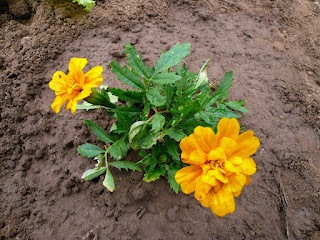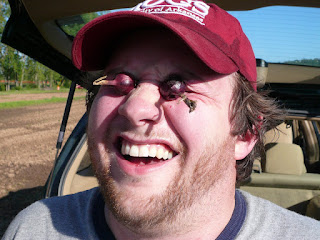Alright, down to business.
Here is a list of what we planted today:
sweet corn
pole beans
sunflowers
peppers (bell, jalapeno, chili and banana)
tomatoes (cherry, Roma, beefsteak, heirloom brandywine)
wildflowers
zinnias
cucumbers
zucchini
okra
carrots
radishes
red onions
Sadly, I don't have enough pictures to correspond to all of this activity. Once I remembered my photography duties, the sun had already begun to set and the light was no good. But I did manage to get a few off before the sun fully set.
But, as you can see, our shadows were l-o-n-g when we finally started packing up.

Here is one of our corn/bean rows. The corn seeds are in back and were placed every 6 inches or so. The beans are in the front part of the row and placed in-between the corn seeds. Also, the sunflowers were planted in the row directly behind the corn/bean row.
 Next up is one of our beautiful little bell peppers. We probably have more bell peppers than any other plant in the garden. Which is good since we eat them ALL THE TIME. We eat them more often than we eat tomatoes.
Next up is one of our beautiful little bell peppers. We probably have more bell peppers than any other plant in the garden. Which is good since we eat them ALL THE TIME. We eat them more often than we eat tomatoes.Most of our pepper and tomato plants are ones we grew from seeds. However, some of our seedlings just didn't look hearty enough for the great outdoors so we hedged our bets and bought some plants at a local nursery.

And here is one of our lovely tomato plants all warm and snug in its cage. The cages, lest you accuse us of tomato cruelty, are strictly for the tomatoes' benefit. They send their little stems out the openings and, as they grow, the cage provides support for those (hopefully) tomato-laden stems.
 We prepared all of the beds today in the same manner as before. Hoe and rake the bed to break up clumps. Scatter peat/compost mixture. Water afterwards with the liquid fertilizer/water mixture.
We prepared all of the beds today in the same manner as before. Hoe and rake the bed to break up clumps. Scatter peat/compost mixture. Water afterwards with the liquid fertilizer/water mixture.You may have noticed that many of our plants have depressions around them. We made those in hopes that during the next rain, which is sure to come any moment now, some rain will gather in these little "volcanoes" instead of running off the side. We'll see how that goes.
Oh the way home, I quizzed Adam about what plant he is most excited to be growing/harvesting/eating and he, of course, said the chili peppers. He wants to make hot sauce.
My "top plant" is definitely my lovely okra! I l-o-v-e okra and simply can't wait until they are ready to harvest.
We have plans for most of the vegetables. But some of them (ahem, radishes) I'm at a loss of what to do with. Especially in such large numbers. I am excited about learning to can and sharing that (possibly harrowing) process with you. Any tips, pass them along. Please.
Naturally, we are pretty tuckered out after such a day. Off to bed we go....with visions of homemade tomato sauce in our heads.








.JPG)














